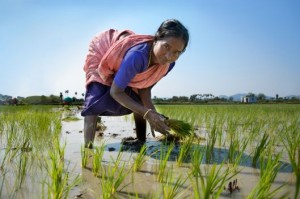
Photo: ifc_skn
As the second most populous country in the world, with a huge and booming economy, India’s future food and water supplies are uncertain. Add to the mix rapid urbanization and a new found passion for consumerism and it is not surprising that some Indian river basins are already experiencing physical water scarcity.
For more than 12 years the International Water Management Institute (IWMI) has been supporting research institutions and policy planners in the Indian government to strive for high quality evidence-based solutions to these challenges, remarked Jeremy Bird, IWMI’s Director General, in his welcoming speech to delegates at the High Level Policy Dialogue held on 3 May, 2013. The event was a unique opportunity to bring together global experts on agriculture and water science with officials doing the one of the toughest jobs in global resource management: guiding India’s rapid transition to a major global economy in an environmentally sustainable manner.
Planetary saturation point
Prof. Johan Rockström, Director of the Stockholm Resilience Centre and Chair of the WLE Steering Committee, outlined a number of key challenges the world faces as it moves into the Anthropocene era in his presentation Sustainable intensification of agricultural development: the scientific support for a new paradigm. “The ‘3-6-9 World’ will see temperatures increase by 3 degrees, the 6th mass extinction of species and a population of 9 billion by the middle of the century: a ‘planetary saturation point’ “, he argued.
Rockström called for a new paradigm to create a safe and sustainable operating space for humanity within planetary boundaries. This will require a major transformation of agriculture. Researchers should focus on the untapped potential of green water, particularly important in a country like India which garners half of its food supply from rain fed agricultural systems.
Reforms take time to materialize
‘Every day we get up and we have to manage something. What does that look like through the lens of water?’ was the opening question posed by Dr. Don Blackmore, Chair of the IWMI Board of Governors and former CEO of the Murray Darling Basin Commission. His presentation on Global Water Challenges: River Basin Management Opportunities and Risks took the audience through a number of case studies for water management reform, with a word of caution that policies for change need to be embedded in institutions and instruments and that reforms take time to materialize.
Around the world, 40,000 large dams have been built since 1950. In countries like Australia, however, which has a very high ratio of maximum to minimum annual river flow, the focus is now on water management, with no new dams built since 1985. Lessons learned from the Murray Darling Basin include the philosophy that it is impossible to manage what cannot be measured or described, with ‘sufficient certainty’ needed for decision makers to sign on to policies.
Water trading for India?
Dr. Tushaar Shah, Senior Fellow at IWMI, facilitated an open exchange whether water trading could work in India, a concept that has proven successful in the Murray Darling Basin in Australia and parts of China. However water entitlements differ in India making it difficult to merge public, private and ‘political’ investments.
Dr. Mihir Shah, member of both the India Planning Commission and the WLE Steering Committee, provided an outline of the water component in India’s 12th Five Year Plan. IWMI’s research and support had been useful in developing the water sector programs for the plan. The water component includes an ambitious program to map aquifers is now underway, as the scale of groundwater depletion remains still unknown. Watershed management strategies will focus on improving agricultural productivity, with full integration of waste water management. A national water framework law is planned which will contain a common set of principles by which states will be held account, and an annual water audit for the private sector to reduce its water footprint.
Efficiency and resilience – a dichotomy
The Dialogue closed with a reminder that there is a dichotomy between efficiency and resilience; systems that are optimized tend not to be resilient to shocks. Investing in natural capital is essential in order to be resilient to potential shocks and move from water problems to water solutions. In other words, we can ramp up agricultural production but if, at the same time, we fail to protect the ecosystems that underpin it, we will be ill prepared for natural disasters like floods and droughts.

